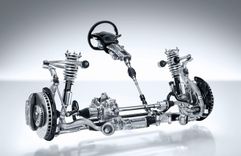

At its most basic, power steering is a system that reduces the effort required of the driver to turn the steering wheel. Without power assist, the steering of most vehicles would be extremely heavy, particularly during low-speed manoeuvres such as pulling into a parking spot, turning a 90-degree corner in the city, or manoeuvring in a crowded gas station.
Before power assist became available, cars' steering systems had been geared so that it took many turns of the wheel to negotiate tight turns or to park. This slow gearing gave drivers more leverage against the high effort required to steer the front wheels. But the advent of power steering allowed engineers to quicken the steering ratio is how much the steering wheel has to be turned relative to how much the angle of the front wheels changes because the additional steering effort could now be offset by the new system. In fact, it was more than just offset; steering a car became nearly effortless.
Electric power steering (EPS) is the norm on today's new cars. There's still a solid metal steering shaft running from the steering wheel to the steering rack, which steers the tires, but the rest is high-tech. EPS uses an electric motor that draws energy from the vehicle's electrical system to provide the steering assistance. This electric motor can be located either directly on the steering rack this arrangement is more expensive and tends to be used on the sports- and luxury-car end of the spectrum or mounted to the steering column.